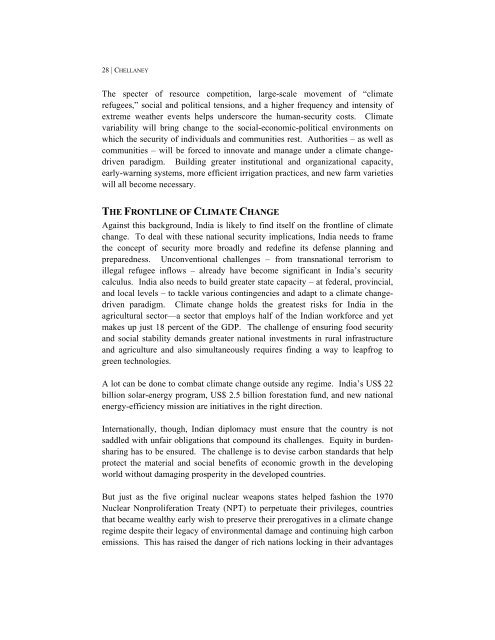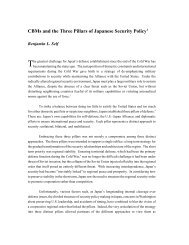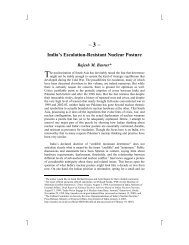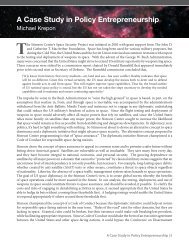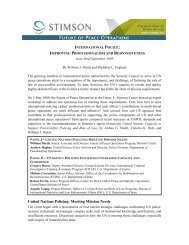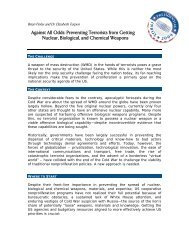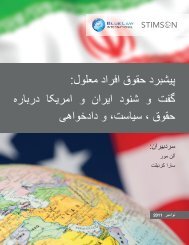Indian Climate Policy: Choices and Challenges - The Stimson Center
Indian Climate Policy: Choices and Challenges - The Stimson Center
Indian Climate Policy: Choices and Challenges - The Stimson Center
Create successful ePaper yourself
Turn your PDF publications into a flip-book with our unique Google optimized e-Paper software.
28 | CHELLANEY<br />
<strong>The</strong> specter of resource competition, large-scale movement of “climate<br />
refugees,” social <strong>and</strong> political tensions, <strong>and</strong> a higher frequency <strong>and</strong> intensity of<br />
extreme weather events helps underscore the human-security costs. <strong>Climate</strong><br />
variability will bring change to the social-economic-political environments on<br />
which the security of individuals <strong>and</strong> communities rest. Authorities – as well as<br />
communities – will be forced to innovate <strong>and</strong> manage under a climate changedriven<br />
paradigm. Building greater institutional <strong>and</strong> organizational capacity,<br />
early-warning systems, more efficient irrigation practices, <strong>and</strong> new farm varieties<br />
will all become necessary.<br />
THE FRONTLINE OF CLIMATE CHANGE<br />
Against this background, India is likely to find itself on the frontline of climate<br />
change. To deal with these national security implications, India needs to frame<br />
the concept of security more broadly <strong>and</strong> redefine its defense planning <strong>and</strong><br />
preparedness. Unconventional challenges – from transnational terrorism to<br />
illegal refugee inflows – already have become significant in India’s security<br />
calculus. India also needs to build greater state capacity – at federal, provincial,<br />
<strong>and</strong> local levels – to tackle various contingencies <strong>and</strong> adapt to a climate changedriven<br />
paradigm. <strong>Climate</strong> change holds the greatest risks for India in the<br />
agricultural sector—a sector that employs half of the <strong>Indian</strong> workforce <strong>and</strong> yet<br />
makes up just 18 percent of the GDP. <strong>The</strong> challenge of ensuring food security<br />
<strong>and</strong> social stability dem<strong>and</strong>s greater national investments in rural infrastructure<br />
<strong>and</strong> agriculture <strong>and</strong> also simultaneously requires finding a way to leapfrog to<br />
green technologies.<br />
A lot can be done to combat climate change outside any regime. India’s US$ 22<br />
billion solar-energy program, US$ 2.5 billion forestation fund, <strong>and</strong> new national<br />
energy-efficiency mission are initiatives in the right direction.<br />
Internationally, though, <strong>Indian</strong> diplomacy must ensure that the country is not<br />
saddled with unfair obligations that compound its challenges. Equity in burdensharing<br />
has to be ensured. <strong>The</strong> challenge is to devise carbon st<strong>and</strong>ards that help<br />
protect the material <strong>and</strong> social benefits of economic growth in the developing<br />
world without damaging prosperity in the developed countries.<br />
But just as the five original nuclear weapons states helped fashion the 1970<br />
Nuclear Nonproliferation Treaty (NPT) to perpetuate their privileges, countries<br />
that became wealthy early wish to preserve their prerogatives in a climate change<br />
regime despite their legacy of environmental damage <strong>and</strong> continuing high carbon<br />
emissions. This has raised the danger of rich nations locking in their advantages


